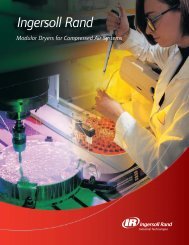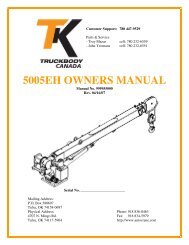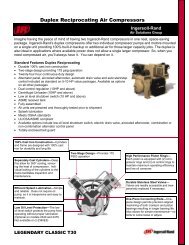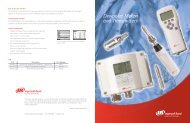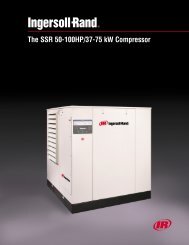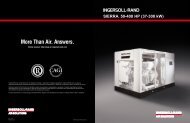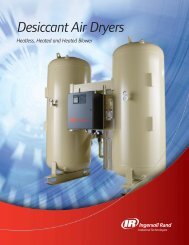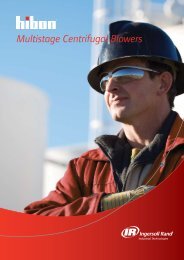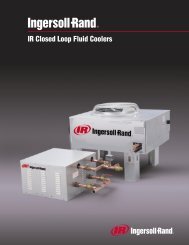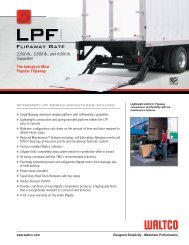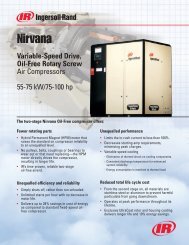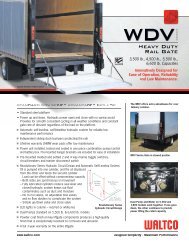Trouble shooting Guide
Trouble shooting Guide
Trouble shooting Guide
Create successful ePaper yourself
Turn your PDF publications into a flip-book with our unique Google optimized e-Paper software.
VMAC UNDERHOOD VR70 and VR140 AirCompressor <strong>Trouble</strong><strong>shooting</strong>Problem: Frequent clutch burnoutPossible CauseTurning on the compressor withpressure still in the systemAlso visit Ogura for additionalclutch trouble<strong>shooting</strong>.Corrective ActionIf the green light isn’t flickering, check theclutch connection.Also, try powering the clutchright from the battery with the engine running.See if it still cuts in and out. Follow TestProcedure 1Problem: The green light on the control box may flicker.Possible CauseLoose connection at:• Clutch,• Interface cable,• Key-switched 12V,• Park Brake,• DDC,• Ground, or• the green connectorbetween the SwitchingBox and Low-ProfileControl Panel.Corrective ActionIf it does, check the resistance between clutchwire (unplugged) and the battery’s negativeterminal. The resistance should be between 2.3- 2.5 ohms. Try wiggling the clutch wire whiletesting to check for an intermittent contact. Ifit does not, work from the Key-Switched 12Vsource, checking each connection.Repair any loose connections found. Probingconnection points with an analog voltage metershould show any intermittent connections.Alternatively, a test light may flicker with anintermittent contact.Problem: The clutch engages and disengages while VR system is running.Possible CauseFailed component in Control Box,Low-Profile Control Panel,Switching Box, or DDC. Theengine may run “rough” whenthe system is on, due to thethrottle power turning on and offwith the clutch.Corrective ActionNote: An Analog meter has a needle thatmoves with voltage, and will flicker as thevoltage changes, whereas A modern digitalmeter samples the voltage many times persecond and averages these values. This canresult in intermittent contact problems beingmissed.Also visit Ogura for additionalclutch trouble<strong>shooting</strong>.Problem: Compressor does not run.Possible CauseFailed component in Control Box,Low-Profile Control Panel,Switching Box, or DDC.Corrective ActionIsolate the Park Brake connection: Disconnectthe black interface cable wire connected to thePark Brake. Connect it directly to ground. Run
Oil temperature too high.Loss of 12 Volt signal at theclutch, blown fuse, broken wiresor a failed switch.the system. Proceed to next step if problempersists.Isolate the DDC: If it is an automatic, removethe DDC from the system, and ground the blackInterface Cable wire. Run the system. Proceedto next step if problem persists.Isolate the Throttle: For electronic throttles, ifpossible, disconnect the red throttle wire tobypass the throttle. Run the system. Proceedto the next step if problem persists.If none of the above corrects the problem, theproblem should be isolated to the control box inthe system. Try replacing the Control Box, orthe Switching Box and Low-Profile Control Panelas a pair. Turn compressor off, allow to cool for30 minutes and restart. Follow Test Procedure 1Problem: No power to the clutchPossible CauseFuse burned or wires damagedAlso visit Ogura for additionalclutch trouble<strong>shooting</strong>.Corrective ActionCheck power at the clutch, replace fuse ifnecessary, replace broken wires or failedswitch.Problem: Engine stalls when the compressor is activated.Possible CauseSystem is under pressure.Blow down valve not workingRPM setting too low or throttlenot set correctly.Corrective ActionAllow 10 seconds for blow–downReplace blow-down valve.Readjust RPM and throttle settings for optimumoperation.Problem: Objectionable noise level.Possible CauseExcessive gear wearMaximum RPM setting higherthan necessary to meet airdemand requirements.Operating with the hood openCorrective ActionContact the nearest dealer to replacecompressor/gearbox assembly.Reduce maximum RPM settings.Close the hood.Problem: Bad clutch ground
Possible Cause Corrective ActionOpen clutch stator windings.Also visit Ogura for additionalclutch trouble<strong>shooting</strong>.With 12 V applied to the clutch check forvoltage between the clutch stator housing andthe engine. If voltage is present, ground thestator.With compressor switch off and clutch wiredisconnected, check resistance between theinput wire and ground.Resistance (less lead resistance) should be 2.5ohms to 3.0 ohms. If outside this range, replacethe stator.Problem: The engine may run “rough” when the system is on, due to the throttlepower turning on and off with the clutch.Possible CauseLoose connection at:Clutch, Interface cable, Keyswitched12V, Park Brake, DDC,Ground, or the green connectorbetween the Switching Box andLow-Profile Control Panel.Corrective ActionWith power off, disconnect the InterfaceConnector (white connector). Check to makesure all the pins and sockets are in the sameposition in the connectors, and that there is nodirt or signs of arcing on them.Repair / replace as needed. For systems withtheLow-Profile Control Panel and Switching Box,check the green connector between them asabove. Recheck system. If condition persists,try to isolate the problem to one component(and replace it as needed):Isolate Power Source issues: Disconnect thekey-switched12V wire and connect it directly to the battery.Run thesystem. Proceed to next step if problempersists.Isolate Grounding issues: Measure theresistance from the greenground connection on the interface cable to thebattery’snegative terminal. This should be less than1ohm. Runthe system. Proceed to the next step if problempersists.Problem: Red lamp pushed part way out of control panel. This could result in therelay operating inconsistently or not operating at all.Possible CauseFactory assembly defect.Corrective ActionBack cover could be removed and the tab onthe red lamp that is touching the relay couldbe bent carefully so that the Tab no longerinterferes with the relay.
Problem: Power fuse blows.Possible CauseShort to ground in the controlcircuit.Incorrect fuse.Incorrect wiring.Corrective ActionLocate and correct short or replace controlpanel.Install correct OEM fuse.Repair wiring according to wiring diagram.Problem: Oil level is too low.Possible CauseExcessive oil carry-overParked on uneven groundCorrective ActionInlet valve.Park on level ground and check level again. Addoil as necessary.Check level at the sight glass and add asnecessaryProblem: Frequent compressor over-temperature shutdowns.Possible CauseDischarge temperature probefailure.High ambient temperatures.Low oil level.Restriction in the compressor oillines.Compressor oil filter pluggedHeat exchanger not functioningor is fouledwith deposits.Engine cooling system failure(engine temperature will behigh).Engine fan clutch slipping.Corrective ActionReplace probe if defective. Follow TestProcedure 2Reduce duty cycle.Check oil on level ground, add as required.Check for kinked or pinched oil lines.Replace oil filter.Remove and clean or replace heat exchanger.Correct engine cooling problems.Replace if defectiveOil temperature probe failure.Problem: Drive belt is broken or missing.Possible CauseAlignment problemsCorrective ActionInstall new compressor belt
Problem: Belt squeals when compressor switch is activated.Possible CauseWorn BeltsSystem is under pressure.Blow-down valve not working.Improper belt tension.Belt is glazed.Corrective ActionCheck alignment of pulleys.Allow 10 seconds for blow-down.Replace blow-down valve.Check belt tensioner.Replace belt.Problem: Low air pressure.Possible CauseAir flow is too high.Throttle control set too lowPressure regulator valve set toolow.Corrective ActionReduce consumption.Increase maximum RPM settingsIncrease pressure by adjusting pressureregulator valve.Problem: Excessive air pressure.Possible CausePressure regulating valve settoo high.Corrective ActionReduce system pressure by adjusting pressureregulating valve.Problem: Oil blows out of compressor air filter on compressor shutdownPossible CauseShutting the engine off whilerunning at high speed.Corrective ActionAllow engine to idle-down before shutting downthe compressor.Turn off any air tools before shutting downcompressor.Problem: Oil drips from clutch after shutdown.Possible CauseSeal leaking.Also visit Ogura for additionalclutch trouble<strong>shooting</strong>.Corrective ActionContact the nearest dealer to replace gearboxinput shaft seal.Problem: Excessive oil in the air.Possible CauseFailed coalescing separatorelement.Corrective ActionReplace element.
Clogged scavenge line screen. Clean or replace parts as required.High oil levelPoor fit between coalescing filterandtank – lack of seal at O-ringsProblem: Engine RPM excessive on initial startup and during operation.Possible CauseMaximum RPM setting is toohigh.Idle-down pressure is too high.Corrective ActionReduce maximum RPM setting of throttlecontrol or reset cable nipple.Reduce idle-down setting of the throttle control.Problem: Engine RPM stays at base idle when compressor runs.Possible CauseMaximum RPM setting too low.Idle-down pressure too low.Corrective ActionTest and correct connectionsAdjust throttle controlsTest and correct connections.Replace throttle control.Problem: Engine RPM over-revs when compressor is activated.Possible CauseThrottle controls not connectedproperly.Throttle control not setupproperly.Corrective ActionIncrease maximum RPM setting of the throttlecontrol or reset the cable nipple.Increase idle-down setting of the throttlecontrol.Check and correct connections.Adjust high idle screw.Problem: Engine RPM does not return to base idle.Possible CauseWiring fault.Throttle not properly adjustedCorrective ActionCheck and correct wiring according to wiringdiagramAdjust idle down screw.Problem: Engine RPM stays at maximum whenever the compressor is runningPossible CauseIdle-down setting is too high.Corrective ActionReset idle-down pressure.
Problem: System is very noisy during operationPossible CauseDefective idler or tensionerbearings.Corrective ActionLocate the source of the noise and replace theappropriate part.Locate the source of the noiseand replace the appropriate part.If the noise is coming from the compressor,replace the unit.Vehicle hood is open.Noise levels can be reduced by closing the hoodwhile operating the compressor.Problem: Engine stalls on activation of the systemPossible CauseThe compressor or clutch isdamagedCorrective ActionMake sure that the system has no residualpressure by venting the tank. Remove thedrive belt and spin the outer part of thecompressor clutch. It should spin freely. Usinga socket and ratchet on the center bolt on thecompressor clutch, turn the compressorclockwise. If the compressor will not turn, ithas internal damage.Problem: Engine stays at base idlePossible CauseThe throttle control is notincreasing enginespeedCorrective ActionElectronic throttle controls, follow TestProcedure 3Pneumatic throttle controls, follow TestProcedure 4Problem: Belt squeals on startupPossible CauseThere is residual air pressure inthe systemThere is insufficient belt tensionThe drive belt is damagedCorrective ActionResidual air pressure in the system will causethe compressor to stall. Vent air pressure andtest again.The belt tensioner may be damaged and is notapplying sufficient tension to the belt. Comparethe tension of the VR7000 belt with the OEMbelt or test the tension with an approvedtension gauge. If the belt seems too loose,replace the tensioner.If the belt is cracked, glazed or is missingpieces, replace the belt.Problem: Clutch slips and is damaged
Possible Cause Corrective ActionInsufficient voltage to the clutchAlso visit Ogura for additionalclutch trouble<strong>shooting</strong>.If the clutch does not receive battery voltage,there will be insufficient magnetism developedand the clutch will not engage correctly. Thiswill cause instant destruction of the matchingsurfaces, as they are not lubricated and cannotwithstand the friction.Follow Test Procedure 5Problem: Engine speed is too highPossible CauseIncorrect adjustment of thethrottle controlCorrective ActionThe cable nipple is not positioned correctly orthe electronic control is not adjusted correctly.Follow the procedures in your Owners ManualProblem: Engine speed is too lowPossible CauseIncorrect adjustment of thethrottle controlCorrective ActionThe cable nipple is not positioned correctly orThe electronic control is not adjusted correctly.Follow the procedures in your Owners ManualProblem: Engine stays at base idlePossible CauseThe throttle control is notincreasing enginespeedCorrective ActionElectronic throttle controls, follow TestProcedure 3Pneumatic throttle controls, follow TestProcedure 4Problem: Engine will not return to base idlePossible CauseThrottle operation hasinterferenceCorrective ActionOn pneumatic throttle controls, check theoperation of the throttleProblem: Air pressure is too highPossible CauseIncorrect regulator settingsDefective regulatorCorrective ActionFollow the procedures in your Owners ManualIf adjusting the regulator does not have anyaffect on pressure and engine speed is correct,replace the regulator.
Problem: Excessive oil in the airPossible CauseOperating angle of the vehicle isexcessive.Oil level is too highCoalescing element is defectiveScavenge line is pluggedCorrective ActionMaintain a level operating position no greaterthan 10 degrees from the horizontalCheck the oil level at the tank and drainsufficient oil to correct the level.Follow the repair procedures to replace thecoalescing element.Clear or replace the line. Check the scavengeline filter for contamination.Problem: Oil blows out of the air filter on shut-down or the air filter is always wetwith oilPossible CauseShutting down the engine beforereturning to idle.Corrective ActionTurn the compressor off FIRST and allow theengine to return to idle.Problem: Air pressure is too lowPossible CauseInsufficient air flow or incorrectregulatorsettingsDefective regulatorCorrective ActionFollow the procedures in your Owners ManualIf engine speed settings are correct andadjusting the regulator has no effect onpressure, replace the regulator.Problem: Frequent relief valve operationPossible CauseAir pressure is too highDefective relief valveCorrective ActionFollow the procedures in your Owners ManualIf pressure settings do not exceed 200 psi,replace the relief valve.Problem: Fuse always blowsPossible CauseShort to ground in the controlcircuit.Incorrect fuseCorrective ActionRecommended fuse is 20 Amps. Check theblown fuse to make sure that it was a 20 Ampfuse. If a 20 Amp fuse blows repeatedly DONOT replace it with a larger fuse.Locate and correct short or replace controlpanel.
Incorrect wiring.Repair wiring according to wiring diagram.System electrical problemsProblem: Red lamp pushed part way out of control panel. This could result in therelay operating inconsistently or not operating at all.Possible CauseFactory assembly defect.Corrective ActionBack cover could be removed and the tab onthe red lamp that is touching the relay couldbe bent carefully so that the Tab no longerinterferes with the relay.Problem: Intermittent operationPossible CausePoor wiring connectionsCorrective ActionFaulty control unit or throttle controlDefective temperature probeDefective pressure transducerProblem: No response from the vehicle throttlePossible CauseFaulty connections between theelectronic throttle controller andthe foot pedalCorrective ActionRemove all of the connectors.Visually check the condition of the pins andsockets.Insert the connectors firmly, making sure thatthe latches on the connectors close.




